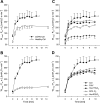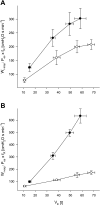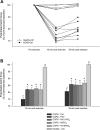Impact of pulmonary system limitations on locomotor muscle fatigue in patients with COPD
- PMID: 20445160
- PMCID: PMC2904150
- DOI: 10.1152/ajpregu.00183.2010
Impact of pulmonary system limitations on locomotor muscle fatigue in patients with COPD
Abstract
We examined the effects of respiratory muscle work [inspiratory (W(r-insp)); expiratory (W(r-exp))] and arterial oxygenation (Sp(O(2))) on exercise-induced locomotor muscle fatigue in patients with chronic obstructive pulmonary disease (COPD). Eight patients (FEV, 48 +/- 4%) performed constant-load cycling to exhaustion (Ctrl; 9.8 +/- 1.2 min). In subsequent trials, the identical exercise was repeated with 1) proportional assist ventilation + heliox (PAV); 2) heliox (He:21% O(2)); 3) 60% O(2) inspirate (hyperoxia); or 4) hyperoxic heliox mixture (He:40% O(2)). Five age-matched healthy control subjects performed Ctrl exercise at the same relative workload but for 14.7 min ( approximately best COPD performance). Exercise-induced quadriceps fatigue was assessed via changes in quadriceps twitch force (Q(tw,pot)) from before to 10 min after exercise in response to supramaximal femoral nerve stimulation. During Ctrl, absolute workload (124 +/- 6 vs. 62 +/- 7 W), W(r-insp) (207 +/- 18 vs. 301 +/- 37 cmH(2)O x s x min(-1)), W(r-exp) (172 +/- 15 vs. 635 +/- 58 cmH(2)O x s x min(-1)), and Sp(O(2)) (96 +/- 1% vs. 87 +/- 3%) differed between control subjects and patients. Various interventions altered W(r-insp), W(r-exp), and Sp(O(2)) from Ctrl (PAV: -55 +/- 5%, -21 +/- 7%, +6 +/- 2%; He:21% O(2): -16 +/- 2%, -25 +/- 5%, +4 +/- 1%; hyperoxia: -11 +/- 2%, -17 +/- 4%, +16 +/- 4%; He:40% O(2): -22 +/- 2%, -27 +/- 6%, +15 +/- 4%). Ten minutes after Ctrl exercise, Q(tw,pot) was reduced by 25 +/- 2% (P < 0.01) in all COPD and 2 +/- 1% (P = 0.07) in healthy control subjects. In COPD, DeltaQ(tw,pot) was attenuated by one-third after each interventional trial; however, most of the exercise-induced reductions in Q(tw,pot) remained. Our findings suggest that the high susceptibility to locomotor muscle fatigue in patients with COPD is in part attributable to insufficient O(2) transport as a consequence of exaggerated arterial hypoxemia and/or excessive respiratory muscle work but also support a critical role for the well-known altered intrinsic muscle characteristics in these patients.
Figures




References
-
- Agusti AG, Barbera JA, Roca J, Wagner PD, Guitart R, Rodriguez-Roisin R. Hypoxic pulmonary vasoconstriction and gas exchange during exercise in chronic obstructive pulmonary disease. Chest 97: 268–275, 1990 - PubMed
-
- Aliverti A, Macklem PT. The major limitation to exercise performance in COPD is inadequate energy supply to the respiratory and locomotor muscles. J Appl Physiol 105: 749–751, 2008 - PubMed
-
- Amann M, Calbet JA. Convective oxygen transport and fatigue. J Appl Physiol 104: 861–870, 2008 - PubMed
Publication types
MeSH terms
Substances
Grants and funding
LinkOut - more resources
Full Text Sources
Medical
Miscellaneous

